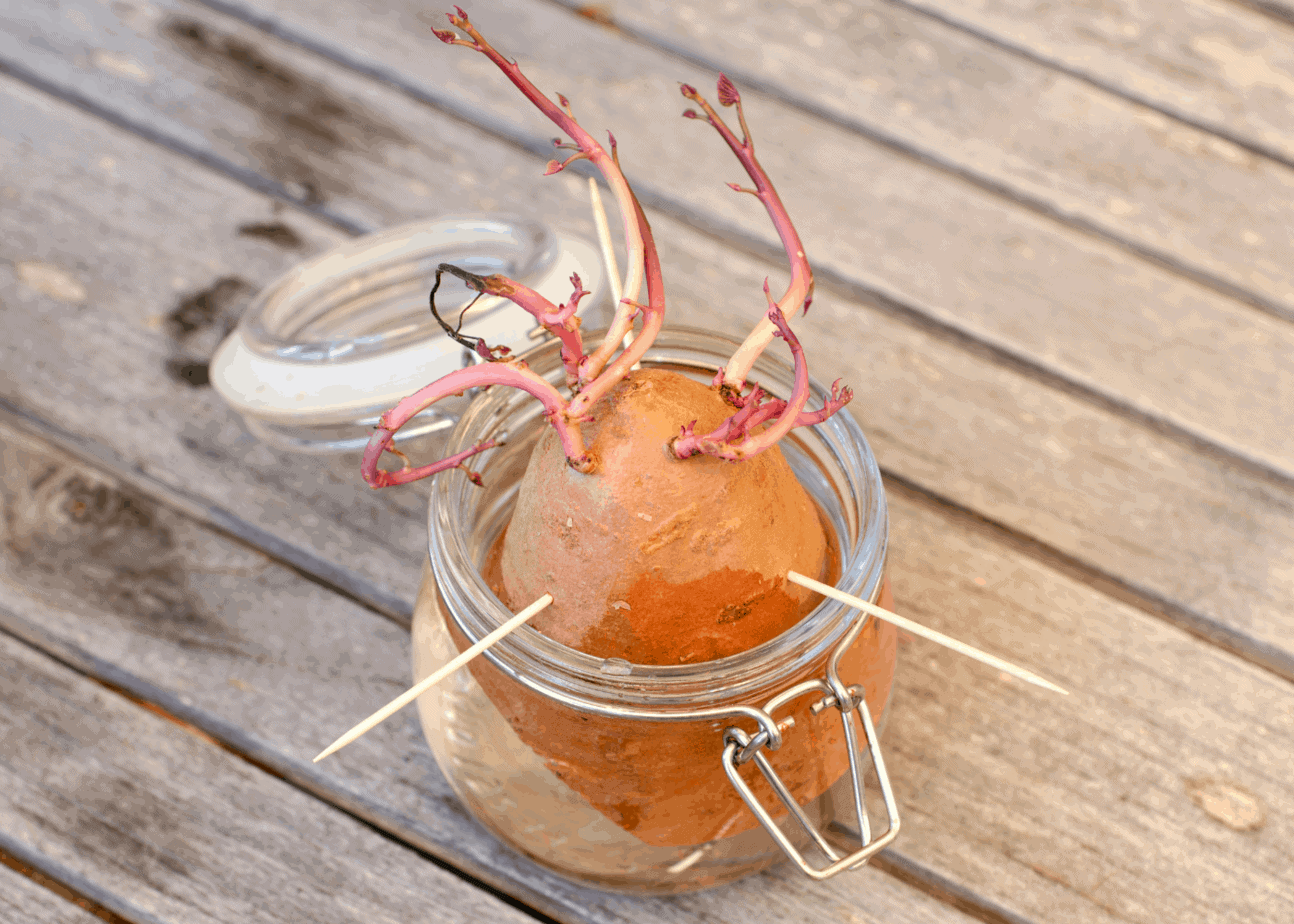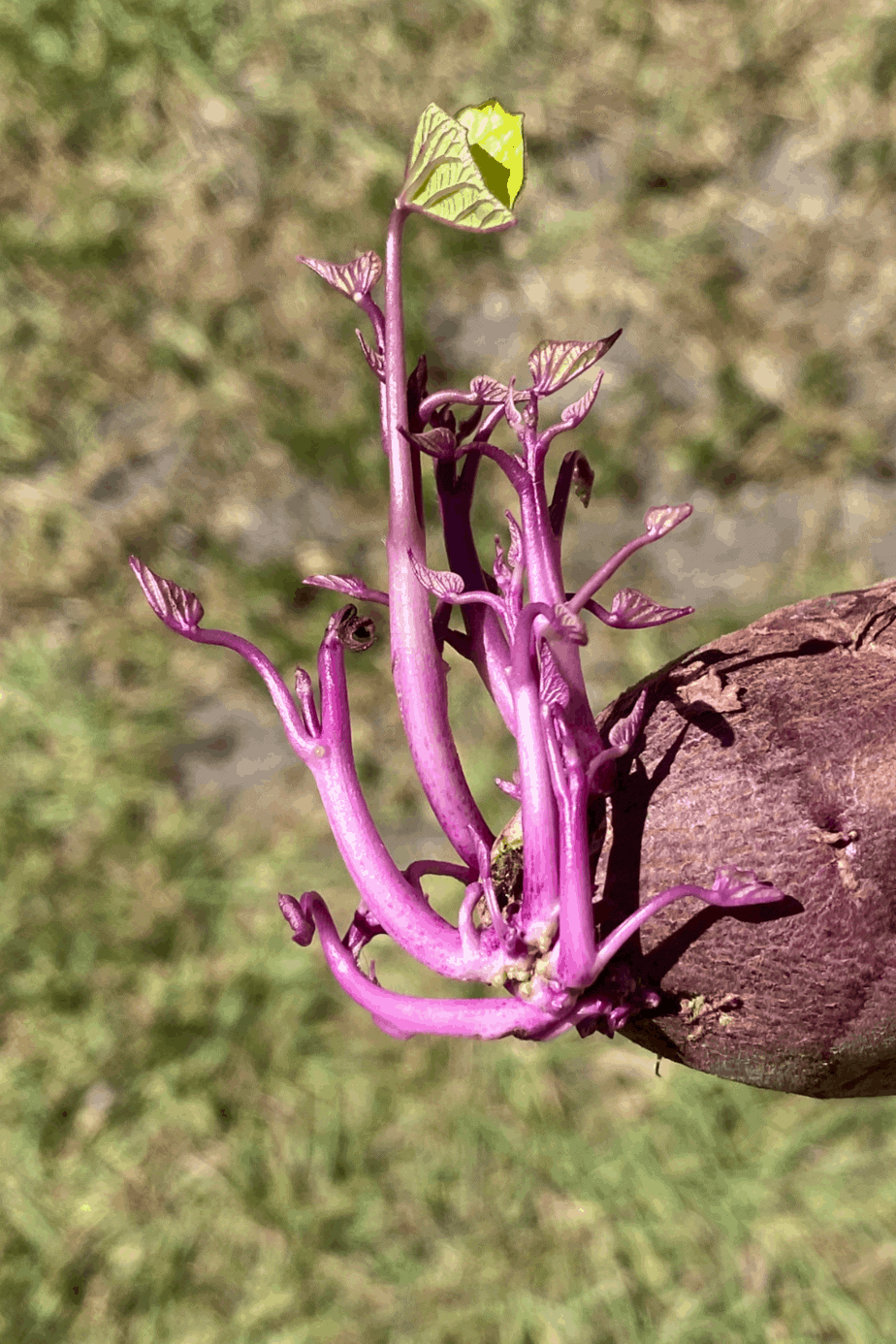Why buy sweet potatoes when you can grow them? These yummy veggies are surprisingly easy to grow. Read on to learn everything you need to know about growing sweet potatoes.

Growing sweet potatoes in your garden
To get started on the right foot, let’s talk about how to grow sweet potatoes. Whether you want to grow your own slips or mail-order them, growing your own sweet potatoes isn’t as hard as you may think!
Sweet potatoes are tropical plants, and as such, they love lots of heat over a long growing season. They need at least four months without frost to produce a healthy crop. Gardeners in cooler areas can grow them inside during chilly spring conditions and in pre-warm outdoor soil with a covering of black plastic.
Start with a slip
Unlike most veggies you can easily grow at home, sweet potatoes don’t start from seed. Instead, they start from “slips” – pieces of other sweet potatoes.
As we mentioned earlier, you can mail order pre-grown slips if you want to cut down on your time, effort, and trial-and-error. However, trying to nurture your own slips can be a fun and rewarding project for the whole family!
To get started, you’ll need a bag of fresh organic sweet potatoes or some seed sweet potatoes. Cut the sweet potatoes in half, or if they’re very large, they can be divided up into even more pieces. Just be sure to leave a few cubic inches of potato so the baby plant has lots of stored energy available to it.

Next, take a cup or mason jar and fill it with water. Insert four or five toothpicks around the perimeter of your sweet potato halves, about halfway between the cut side and the top. You want to submerge the cut side of your sweet potato pieces in water, and the toothpicks rest on the rim of your cup or jar to keep the top end nice and dry.
Place your prepared sweet potato halves in a warm place. This may be a sunny windowsill or on top of a radiator, depending on your climate. Make sure that you’re changing the water every day, or more frequently if you notice that the water is getting cloudy before 24 hours is up!
Separating and rooting your slips
After about two weeks, you should get some nice leafy sprouts coming out of the top of your sweet potato and roots growing into the water. Those leafy sprouts are your slips, and it’s time to separate them from their sweet potato mama!
Gently twist the sprouts away from the base of the potato, selecting only those that look healthy. Then, place them in a small container of water so that the bottoms are submerged in water while the tops remain dry. Leave this in a warm environment that gets a good amount of light and change the water daily.
Within a few days, you should start seeing roots. Once again, select the strongest slips with the healthiest-looking roots. Discard any slips that look wilted or diseased. If your slips have failed, it is generally quite easy to find starter seed potato plants at the garden center or plant nursery.

Get your soil ready for planting
Sweet potatoes need nice, loose soil. In fact, the looseness of the soil is one of the most important factors that will affect how well your sweet potatoes grow! Make sure you have the right soil before you start planting, as your typical gardening soil may not contain the right properties to allow your sweet potatoes to thrive. Sweet potatoes, like regular potatoes, grow very well in grow bags (and there’s less digging too!).
I suggest using well-drained sandy loam soil for sweet potatoes. If you like to get technical with your gardening, note that sweet potatoes want an acidic pH level between 5 and 7.5. You can also use a high-quality organic potting mix if you’re growing your sweet potatoes in containers.
Ultimately, the soil should be loose to allow the plant’s tubers to expand without resistance. You also want good drainage because while sweet potatoes do love water, they don’t do well in stagnant or pooling water. If the soil doesn’t drain, you run the risk of growing rotten or diseased spuds, and no one wants that!

Time to plant your future sweet spuds!
Once your soil is prepared and your slips are showing nice, strong roots, it’s time to start planting!
Grab a hand trowel and dig a hole that is about 4 to 5 inches deep and 3 inches wide. I like to leave about 10 inches to a foot between each slip to ensure that each plant has all the room that it needs.
Place one slip in each hole so that the bottom half is underground and the new leaves are exposed. When you’re filling in the space around the slip and tamping down the dirt, do so gently. Slips are fragile, and you don’t want them to bruise!
A note to gardeners across the nation: remember that your growing season depends on your climate. According to the Almanac, sweet potatoes need 3 to 4 months of warmth in order to produce delicious tubers. If you live in a state with cold winters, planting your sweet potato slips 3 or 4 weeks after the final spring frost should yield good results.

Taking care of your sweet potato plants
After planting your slips, give them a good long drink of water. The dirt should be thoroughly moist but not so wet that your dirt is eroding.
For the first week, you’re going to want to water your slips daily. By the second week, start watering every other day. Each week, you will lengthen the amount of time between waterings into you’re only watering once a week, which you’ll keep doing until it’s time to harvest.








Thank you for this article. Just wondering about when and with what to fertilize the sweet potatoes?
Hi Jake! For my sweet potatoes, I just use a good-quality veggie potting mix that already contains a nice balanced organic fertilizer. They’re not particularly heavy feeders, but the plants need moderate amounts of nitrogen and potassium to thrive. Nitrogen leaves the soil quickly, and is usually applied right before planting or a few weeks after planting. If you’re growing your crop in nutrient-depleted soil, check out these recommendations from Oklahoma State: https://extension.okstate.edu/fact-sheets/sweet-potato-production.html